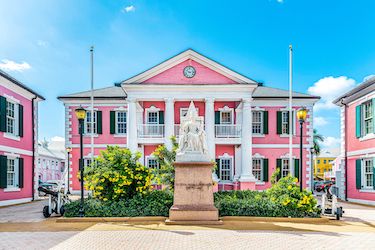
Bahamas. Officially the Commonwealth of The Bahamas. An island country within the Lucayan Archipelago of the Atlantic Ocean. It contains 97% of the Lucayan Archipelago’s land area and 88% of its population.
The archipelagic country consists of more than 3,000 islands, cays, and islets in the Atlantic Ocean, and is located north of Cuba and northwest of the island of Hispaniola (split between the Dominican Republic and Haiti) and the Turks and Caicos Islands, southeast of the U.S. state of Florida, and east of the Florida Keys.
The capital is Nassau on the island of New Providence. The Royal Bahamas Defence Force describes The Bahamas’ territory as encompassing 180,000 sq. mi. (470,000 km2) of ocean space.
The Bahama islands were inhabited by the Arawak and Lucayans, a branch of the Arawakan-speaking Taíno, for many centuries. Christopher Columbus was the first European to see the islands, making his first landfall in the “New World” in 1492 when he landed on the island of San Salvador.
Later, the Spanish shipped the native Lucayans to Hispaniola and enslaved them there, after which the Bahama islands were mostly deserted from 1513 until 1648, nearly all native Bahamians having been forcibly removed for enslavement or having died of diseases that Europeans brought with them from Europe.
In 1649, English colonists from Bermuda, known as the Eleutheran Adventurers, settled on the island of Eleuthera.
The Bahamas became a British crown colony in 1718, when the British clamped down on piracy.
After the American Revolutionary War, the Crown resettled thousands of American Loyalists to The Bahamas; they took enslaved people with them and established plantations on land grants. Enslaved Africans and their descendants constituted the majority of the population from this period on.
The slave trade was abolished by the British in 1807. Although slavery in The Bahamas was not abolished until 1834, The Bahamas became a haven of manumission for African slaves, from outside the British West Indies, in 1818.
Africans liberated from illegal slave ships were resettled on the islands by the Royal Navy, while some North American slaves and Seminoles escaped to The Bahamas from Florida.
Bahamians were even known to recognise the freedom of enslaved people carried by the ships of other nations which reached The Bahamas. Today Black-Bahamians make up 90% of the population of 400,516.[14]
The country gained independence from the United Kingdom in 1973, led by Sir Lynden O. Pindling. It shares its monarch with the other Commonwealth realms. The Bahamas has the fourteenth-largest gross domestic product per capita in the Americas. Its economy is based on tourism and offshore finance.